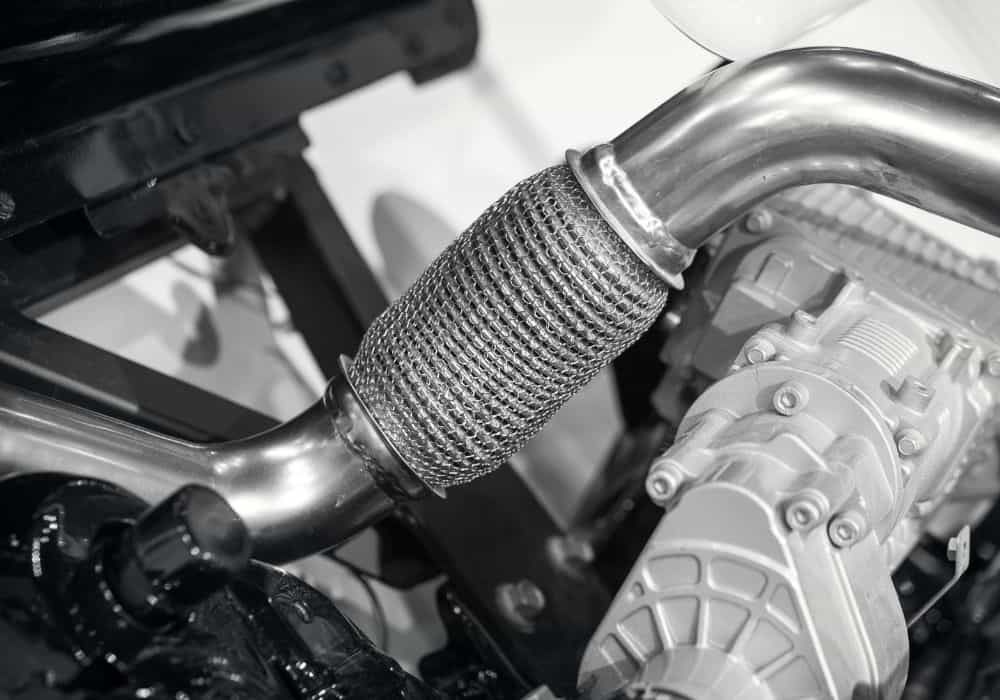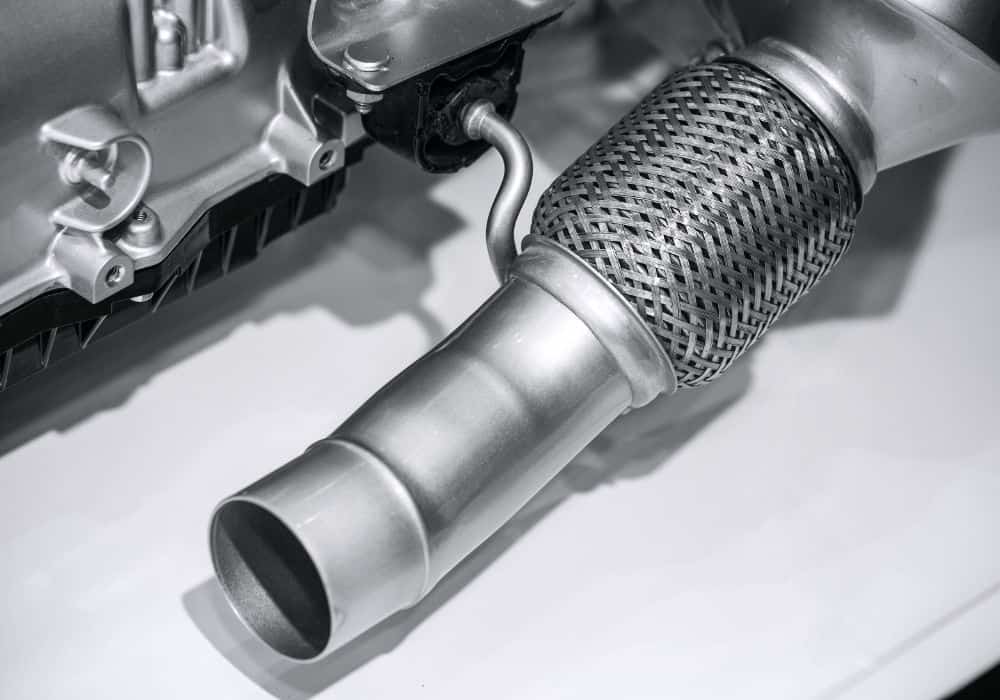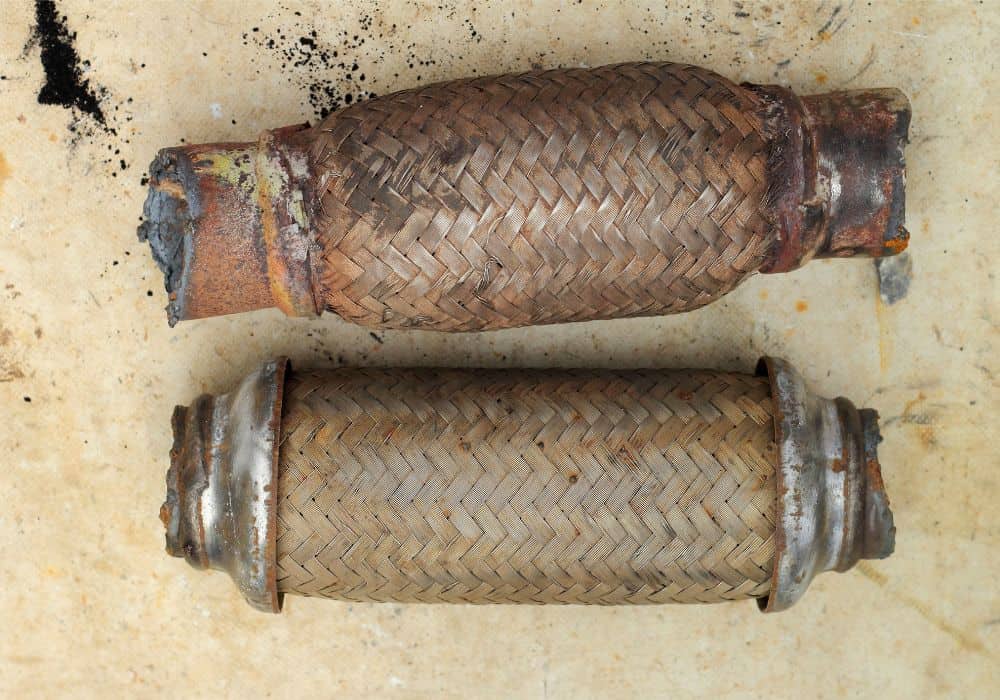If you have noticed performance issues with your automotive exhaust pipes, it may be because the flex pipe needs fixing or changing. But what is a flex pipe? Unless you work with cars or are a car enthusiast, you might not have heard about a flex pipe before.
In this article, we have explained what a flex pipe is. You will also find information about when to change your flex pipe and what type of flex pipe you need. We have also included step-by-step instructions on how to change the exhaust flex pipe yourself.
Read on to find out all you need to know about flex pipes.
What is The Exhaust Flex Pipe?
An exhaust flex pipe is a flexible tube and a part of the car’s exhaust system. Usually, flex pipes are made of stainless steel to give the exhaust line the required flexibility during the movement of the vehicle. The pipe must be flexible as this helps to limit cracks that could otherwise appear in the exhaust system.
Most exhaust flex pipes are made of braided steel, which gives them flexibility. The pipe is either double or triple braided depending on the type of vehicle. As a general rule, petrol cars will have double-braided flex pipes while diesel cars will have triple-braided flex pipes. They come in different diameters as well as braiding.
What Does The Exhaust Flex Pipe Do?
In vehicles, the engines move a little during operation. The role of the flex pipe is to absorb vibrations that are produced by the engine. Because it absorbs the vibrations, it stops the other components from being affected by the vibrations.
The flex pipe allows the engine to move without cracking or rupturing what would otherwise be an inflexible metal tube. Typically, flex pipes are located where the exhaust manifold meets the mid-section of the exhaust of the downpipe.
When Should You Change Or Repair Your Flex Pipe?

How often you need to change the exhaust pipe of your car, depends on how much your use your car. The more you drive, the sooner you will need to change it. After a certain amount of usage, the movements the car exerts on the flexible exhaust pipe will deform it or even cause it to crack.
Your pipe might also need changing if it has been attacked by rust or has torn because of the excessive pressure if the catalytic converter gets blocked.
What To Do About Flex Pipe Exhaust Issues?
Time and usage will take their toll on your flex pipe exhaust and lead to broken components, damaged joints, and leaks. What should you do when this happens? Follow the steps below to limit the damage.
1. Assess The Damage
When you notice there is a problem with your exhaust flex pipe, the first thing to do is to inspect the pipe. Is there a leak at a joint or perhaps a puncture in the component? Perhaps it is making loud noises during acceleration, or there are cracks?
When you closely inspect the pipe, it will help you decide if it will require immediate attention.
2. Find Temporary Solutions
Depending on what your exhaust pipe is a part of, for example, your car or a generator, it may be possible to put off the repairs temporarily. However, if it is a vital piece of machinery, you should find a temporary fix while you search for a more permanent solution.
Also, if the issues are caused by an exhaust leak, you want to prepare it as soon as possible as it can not only affect your fuel efficiency but also leak dangerous fumes.
3. Determine What Needs Repairing or Replacing
Depending on the situation, you may not need to buy a new exhaust flex pipe. While you might be able to salvage it, a better long-term solution is usually to replace the damaged pipe with a new exhaust flex pipe.
4. Purchasing a Replacement
When you buy a replacement exhaust flex pipe, ensure the flex joint is made of the right materials. Research your options thoroughly or consult a professional to ensure the replacement part is the right one for you.
Different Types of Flex Pipes

If you are replacing the flex pipe on your exhaust, you need to know which type to choose. They are mostly differentiated by the temperatures they can withstand.
Up to 650°C
If you have a petrol engine, use a flex pipe and connectors that have a range of up to 650 ° C at the rear silencer. In diesel engines, the connector will be used immediately after the particle filter. The flex pipe used can be a two-layer construction because the exhaust system does not exceed 20 psi working pressure.
Up to 800°C
If you need to connect the flex pipe at the start of the exhaust system, you will need one that can withstand high-temperature conditions, up to 800 ° C. In this part of the system, the pressure regularly exceeds 20 psi, so you will need a triple-braided construction.
Above 800°C
Sometimes you need a connection with the wastegate in the turbo system as in, for example, the VW Touran. The purpose is to reduce the vibration that is transmitted to the turbocharger. These pipes require a special three-layer construction to withstand extreme heat.
How to Replace Exhaust Flex Pipe?

If there is damage to your flex pipe and repair is not an option, you will need to replace the old pipe with a new one. You might like to get a mechanic to handle the replacement. However, it is possible to do it yourself. Below, you will find the steps to installing a replacement flex pipe.
Step One
You need to get under the car, so raise your car first either using a lift or raising the back end with hand-pumped jacks. When using jacks, check extremely carefully that they are secure before getting under the raised end of the car.
Step Two
Locate the flex pipe. Your owner’s manual should show where it is on your car. Alternatively, just look under the car with a flashlight. You will find one end of the flex pipe connected to the muffled with a flange. The other will connect to the exhaust pipe with a pipe elbow.
Step Three
Secure your wrench around the bolts that hold the flex pipe to the muffler’s flange. Use a wrench. Turning it counterclockwise will remove the bolts. Now pull the flex pipe out.
Step Four
Remove the clamp holding the flex pipe using your wrench. This releases the old flex pipe. Set it aside.
Step Five
Between the muffler flange and the flex pipe, you will find the gasket. Pull it out. Now you can clean the flange with a stiff wire brush.
Step Six
Check for any dents at the end of the downpipe of the exhaust. If there are any, hammer these out. Getting rid of dents will allow the new flex pipe to seal tightly to the downpipe.
Step Seven
The next step is to loosen all the nuts that hold the muffler and the downpipe. You may have to move them both slowly so you can fit the new flex pipe in.
Step Eight
Use an exhaust sealer to coat the new muffler and place it in the muffler flange. Then fit the end of the new flex pipe over the exhaust. Use the end of the flex pipe that has a hard elbow as it has holes for the bolts.
Step Nine
Next, use the exhaust sealant again to coat the end of the downpipe. Place the free end of the new flex pipe over the downpipe. You may need to adjust the muffler’s position and the downpipe so that the flex pipe is installed straight and there is no tension in it.
Step Ten
When the flex pipe is straight, thread the bolts through the holes at the end of the pipe. Tighten them with a wrench to secure the pipe to the flange.
Step Eleven
Where the flex pipe meets the downpipe, secure them in place with a clamp. Tighten with a wrench and finish by re-tightening the bolts that hold the downpipe and the muffler. Cut plastic ties from the flex pipe.
If you would like more support on how to perform this task, you might like to watch this video on DIY change of flex pipe.
Conclusion
We may not pay a lot of attention to flex pipes when we are driving unless there is a problem with this flexible piece of pipe. You will soon feel and hear the symptoms of a bad flex pipe as it no longer effectively absorbs the vibrations.
While some will choose to replace the flex pipe themselves, others will prefer to ask a professional technician for quotes on flex pipe repair costs.
If you would like to ask us anything about what flex pipes are or how to fix a broken flex pipe, you can write your questions in the comments section.
